
MARS NORTH POLAR BIO-LIFE-2
Report #124
August 16, 2007
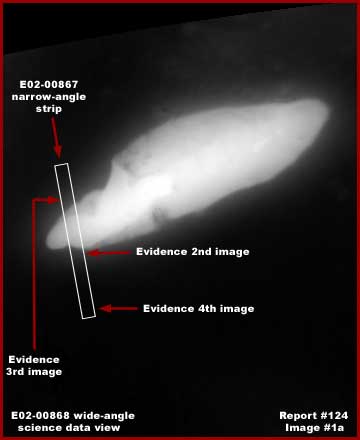 ...
...
As far as the poor quality heavily obfuscated satellite imaging will allow us some decent insight, the South Polar Region story is one generally about surface water and a great variety of biological forestation life competing with each other for space and resources. In comparison, the North Polar Region is a story not so much about surface water plenty but more about more colder hardy forestation and the proliferation of the "dune" appearing dominant mega bio-life and some samples of this mixture is what this report is about.
The above first 1a and 1b images are a regional E02-00868 wide-angle context view. The official statistics indicate that the view here is roughly just under 132 km or 82 miles wide including the dark areas. The left image shows the white outline location of the E02-00867 narrow-angle strip within it and the location of my next three evidence images below within the narrow-angle outline. As you can see, the 1a strip on the left is very dark but with this very bright oblong patch in it.
It is a mystery because this is a very bright patch that just shouldn't be this way against such a dark surrounding terrain background. It may be in part due to the camera and filters used but I suspect that more than that is going on here. I suspect that some growth within the bright patch boundaries is absorbing and regenerating (not just reflecting) light in what is probably a twilight camera view of this site with the terrain around the bright patch made up of a darker color light absorbing bio-life
Note that the lightened 1b image on the right suggests that the bright patch is cradled in a depression rather than being an elevated mass. If you will remember, it was the same with the interior of a large crater pit presented in the last #14, #15 and #16 images in Part-3 of my last Report #123 titled Mars North Polar Bio-Life-1. I can't know for sure here of course but I suspect we are looking at some type of densely packed bio-luminesent-life growth that is doing this and this may apply to the crater pit interior lining in previous Report #123 as well. You'll see what little detail can be seen of this bright patch evidence in my next second image below.
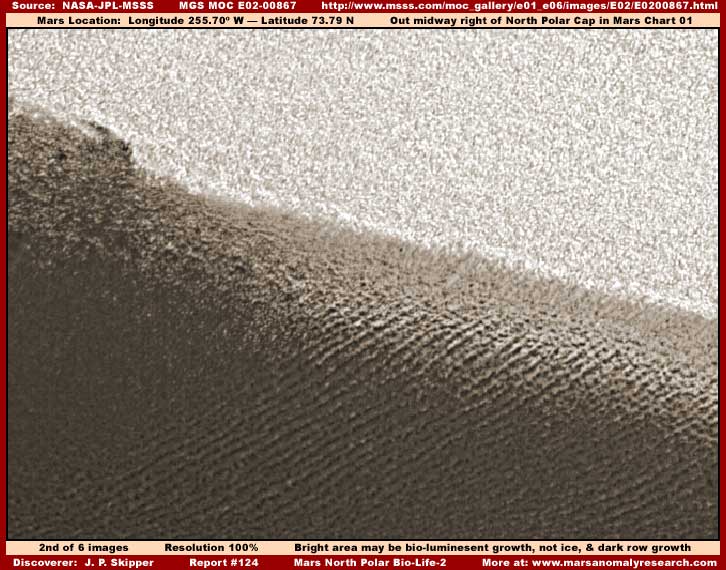
In the above second image from the same E02-00867 narrow-angle strip, the upper half of the image is the bright patch evidence darkened down so that a little detail can be seen within all that brightness while still supplying a decent view of the adjacent peripheral terrain bordering it. As you can see, the bright patch seems to consist of many thousands of super densely packed small uniform objects in a rough texture terrain pattern. Also, note in the adjacent terrain that again the bright reflective patch appears as though it may be resting in a large but shallow depression.
Because of its huge size this bright patch area can be distinctly seen even in the global scale North Polar Region imaging. It is officially referred to as a North Polar "Outlier." I have no doubt that this means that this particular bright area is supposed to be an outflung island of CO2 ice cap mass separated some distance out from the main ice cap mass and perhaps a remnant piece left there from a time in the past when the North Polar Cap was larger. It sounds reasonably plausible, but I'm afraid that I just can't buy into it.
The densely packed individual small uniform objects constituting the bright area as seen in the above second image tend to deny this. The lack of sufficient reflected sunlight in the terrain that surrounds this bright patch area cannot be adequately explained by light reflectivity off of an ice mass alone and that too tends to deny it. Further, I've seen this same bright patch phenomenon on smaller scales in other dark area sites on Mars far removed from the ice caps and ice masses that can't be explained in this way.
In the above second image, note the darker lower half area and the many rows there. This may not be familiar to the Earth human eye but it is biological life and not geology. Note also how the dark mostly light absorbing rows are still clearly reflecting light generated from the bright area revealing a rounded terrain elevated hump there near the edge of the bright area and with lower level terrain in shadow further out to the left of that. This again suggests that the bright area is in a shallow depression rather than being an elevated ice mass accumulation and a remnant part of an old polar cap ice mass.
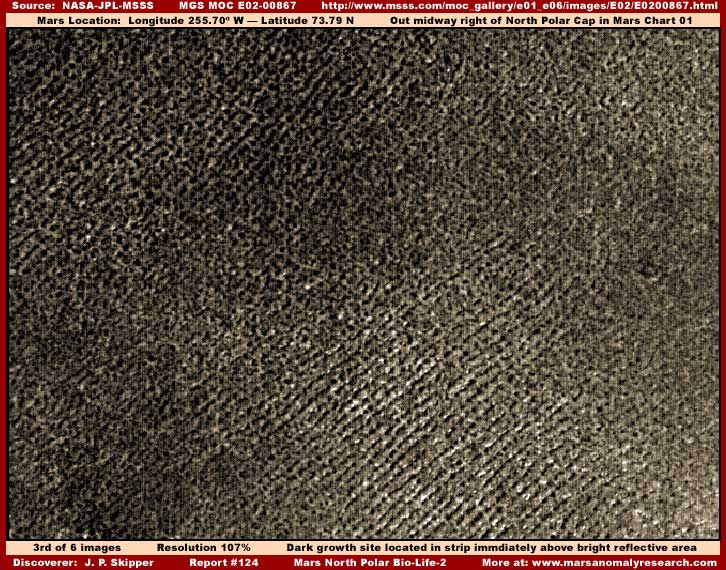
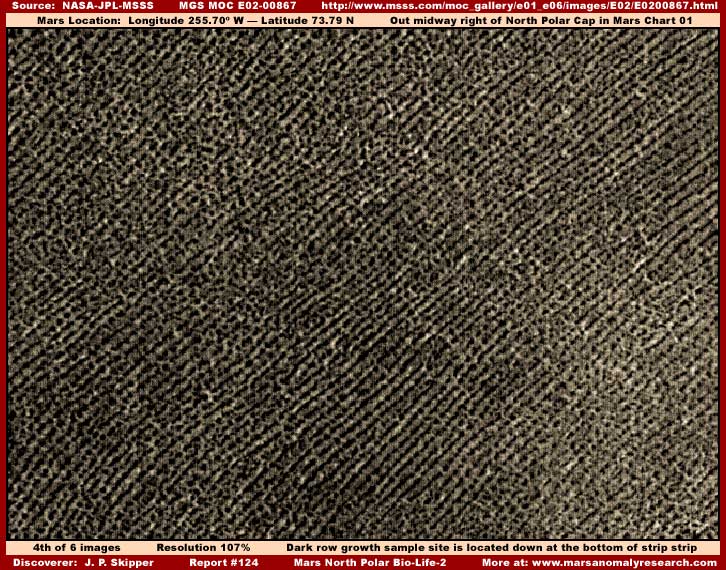
Now we'll move on beyond the bright patch area evidence and consider the above third and fourth evidence images. At first glance they may appear to be uniformly the same scene but the third image is just a representative sample of the dark terrain area above the bright patch while the fourth image is a representative sample from the area below and all the way on the other side of the bright patch area. Except for the bright patch area, the row evidence makes up the entire rest of the strip.
In their endless row after row, this evidence sort of reminds one of fingerprint ridge and groove patterns. However, these two scenes represent the full view of the E02-00867 narrow-angle strip from one side edge to the other. That distance, according to the official statistics, is 3.27 km or 2.03 miles across.
Why am I showing you this? Because you are not looking at geology, you are looking very dense biological life row growth of some kind unfamiliar to the Earth human experience and it is covering everything at this site. This very distinct growth is just one of a number of unfamiliar (to us) growths that cover great expanses in the North Polar Region. Because of this and its visual readily apparent rigid uniformity, it is not easily passed off as geology and it is therefore the target of much image tampering obfuscating it. Fortunately, this strip has less of this in it providing a decent if distant view. A closer view runs quickly into resolution problems in this strip and doesn't add any more information, so I'm not going to try to include a closer view of the evidence here.
I've presented two different sample images of this evidence to demonstrate just how large its coverage area is and how uniform looking it is. It surrounds this bright patch area and you have an idea how large that it is, so this type of bio-life evidence may be hundreds of miles across. This growth is typical of so many bio-life growths on Mars that via their aggressiveness and old growth super density eventually over time tends to dominate huge areas of terrain with no other life able to compete with it for space and resources within its huge forest boundaries. The exception appears to be what ever constitutes the bright patch that is able to flourish in depressions like islands in this huge sea of life.
But, is that the only exception and the only evidence to bring to your attention here? The answer to that is no. Like the South Polar Region, the North Polar Region is about different types of bio-life growth forests but, unlike the South Polar Region, the North Polar Region is also about the huge smooth texture objects that look so much like "dunes" and have been officially identified as that. This identification implies that they are like the sand dunes we are familiar with here on Earth and we know that Earth sand dunes are all about inanimate solid particulate geology subject primarily to erosion, shifting and building wind forces.
However, on Earth, when ever you
see a elevated sand dune, around it or nearby it you will find evidence of
the solid particulate loose sand resource that helped contribute to its formation.
Now that is most often not the case on Mars where the "dunes" most
often appear to exist in terrain devoid of any evidence of the loose solid
particulate resource that would contribute to their creation. Now at this
point, if you are not already familiar with it, review my 2001 Report
#017, 2003 Report
#49, 2005 Report
#088, and 2007 Report
#123 where I was at first puzzling with this concept in the early years
of this work and then my suspicions and this insight continued to evolve.
Now take a look at the evidence below.
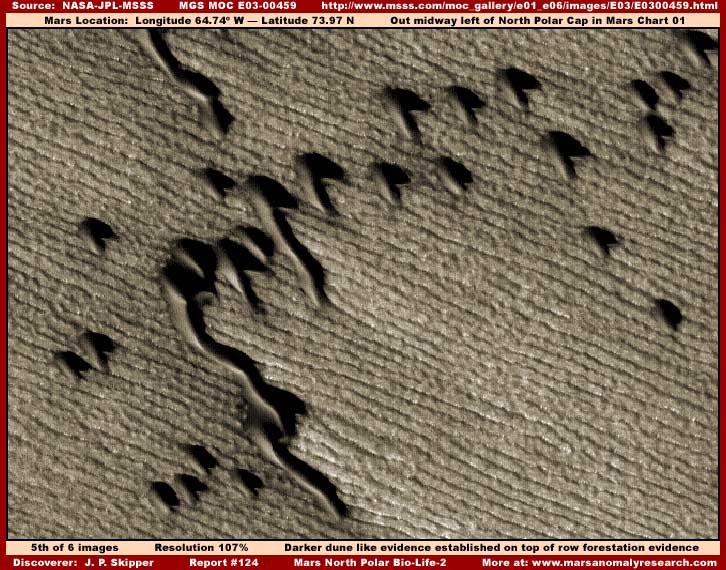
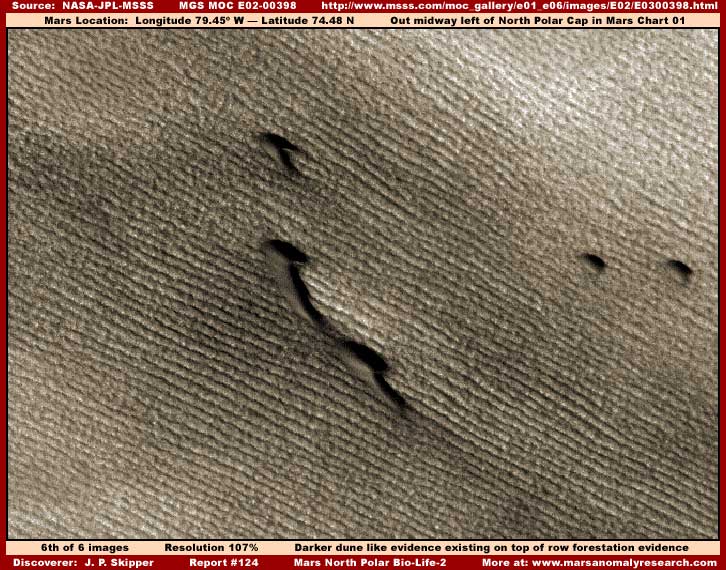
The above fifth and sixth image evidence from two different strips are located all the way around on the opposite side of the North Polar Cap just to demonstrate how wide spread this type of forest evidence is. Now it becomes clear why I wanted you to be familiar with the row forest evidence and be able to recognize it for what it is. As you can see, here the "dune" evidence appears to be resting right on top of the row forest evidence. Note that, unlike the different type of forest evidence in Report #123 growing in between and among the dune looking forms, here the dune looking forms clearly appear to be on top of this rigidly organized type of forestation.
This tends to suggest that the dune looking forms may be of a lighter weight than expected as compared to one's perception being influenced and clouded with the preemptive official initial "dunes" geology association fostered on us. The concept demonstrates just how effective preemptive official level verbal characterizations can be in obscuring evidence along with the visual obfuscation tactics. This dune looking objects on top of the forest concept also tends to suggest that this evidence may possibly even be mobile to some extent and not fixed in place.
Regardless of whether you can entertain such thought provoking pathways or not, at the very minimum evidence like this confirms that there is absolutely no loose particulate soil geology present in the environment that could have contributed to these dune looking objects creation. Note that the view here is from one side edge of the official strips to the other side. According to the official statistics that is 3.26 km or 2.03 miles across for strip E03-00459 and the fifth image and 3.28 km or 2.04 miles across for strip E02-00398 and the sixth image. That equates to plenty of view angle to detect any nearby sand deposits and it just isn't there. This demonstrates that these objects, what ever they may be, are at minimum definitely not dune geology. If nothing else, at least get that concept.
So in recap we've examined three different potential forms of life evidence in this one report, none of which are familiar to the Earth experience but at least awareness of Mars and its unique evolution pathway is expanded a bit further. It also demonstrates that truthful information as publicly released about the exploration of this planet and the question of surface water and life existing on the planet is basically nonexistent at official level. Clearly that means that this will need to be corrected before long unless you find pervasive inaccuracy, pretense, and illusions acceptable in your publicly paid for science data.
Meanwhile, although you've now been exposed to a fair amount and variety of the "dune" looking evidence in this report and those others linked to here and its association as life, you haven't seen the real super life yet. My next report will take this to the extreme and stretch your grasp of this and your concept of "it just can't be" even further. Look for it.
DOCUMENTATION
http://www.msss.com/moc_gallery/e01_e06/images/E02/E0200867.html: This link takes you to the official E02-00867 narrow-angle science data image strip and E02-00868 wide-angle science data image strip that my 1–4 evidence images were drawn from.
http://www.msss.com/moc_gallery/e01_e06/images/E02/E0200868.html: This link takes you to the official E02-00868 wide-angle science data image strip that my measurements for that strip were drawn from.
http://www.msss.com/moc_gallery/e01_e06/images/E03/E0300459.html: This link takes you to the official E03-00459 narrow-angle science data image strip that my fifth evidence image was drawn from.
http://www.msss.com/moc_gallery/e01_e06/images/E02/E0200398.html: This link takes you to the official E02-00398 narrow-angle science data image strip that my sixth evidence image here was drawn from.
, Investigator
![]()